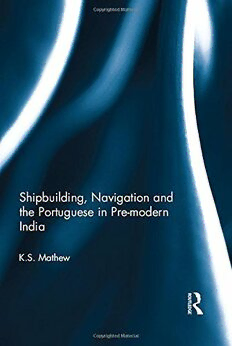
Shipbuilding, Navigation and the Portuguese in Pre-modern India PDF
Preview Shipbuilding, Navigation and the Portuguese in Pre-modern India
SHIPBUILDING, NAVIGATION AND THE PORTUGUESE IN PRE-MODERN INDIA Shipbuilding, Navigation and the Portuguese in Pre-modern India K.S. MATHEW Firstpublished2018 byRoutledge 2ParkSquare,MiltonPark,Abingdon,OxonOX144RN andbyRoutledge 711ThirdAvenue,NewYork,NY10017 RoutledgeisanimprintoftheTaylor&FrancisGroup,aninformabusiness ©2018K.S.MathewandManoharPublishers&Distributors TherightofK.S.Mathewtobeidentifiedasauthorofthisworkhasbeen assertedbyhiminaccordancewithsections77and78oftheCopyright, DesignsandPatentsAct1988. Allrightsreserved.Nopartofthisbookmaybereprintedorreproducedor utilisedinanyformorbyanyelectronic,mechanical,orothermeans,now knownorhereafterinvented,includingphotocopyingandrecording,orin anyinformationstorageorretrievalsystem,withoutpermissioninwriting fromthepublishers. Trademarknotice:Productorcorporatenamesmaybetrademarksor registeredtrademarks,andareusedonlyforidentificationandexplanation withoutintenttoinfringe. PrinteditionnotforsaleinSouthAsia(India,SriLanka,Nepal, Bangladesh,Afghanistan,PakistanorBhutan). BritishLibraryCataloguinginPublicationData AcataloguerecordforthisbookisavailablefromtheBritishLibrary LibraryofCongressCataloginginPublicationData Acatalogrecordforthisbookhasbeenrequested ISBN:978-1-138-09476-5(hbk) ISBN:978-1-315-10118-7(ebk) TypesetinDanteMTStd11/13 byRaviShankerDelhi110055 Contents Acknowledgements 7 I. Introduction 9 II. Shipbuilding and Navigation in India Prior to 1500 26 III. The Arrival of the Portuguese in India: Early Interactions 66 IV. Portuguese Shipbuilding in India 103 V. Portuguese Claims to the Exclusive Domination of the Indian Ocean Regions 135 VI. Life on Board a Portuguese Ship of the Sixteenth Century 173 VII. Conclusion 200 Bibliography 207 Index 217 Acknowledgements The idea of working on the different aspects of naval architecture and navigation in pre-modern India, especially during the sixteenth century when there was close interaction between the Indians and the Portuguese, took root in my mind ever since I started research on Indo-Portuguese history in the 1970s. This was envisaged to make a comparative study of the indigenous and Portuguese techniques of shipbuilding and navigation and to identify the mutual give and take if any. This long cherished plan was materialized easily with the award of a Short-term Research Fellowship by the Fundação Oriente, Lisbon and Emeritus Fellowship by the University Grants Commission, government of India. My heart-felt thanks are due to the president and the director of Fundação Oriente and to the University Grants Commission for providing financial assistance to complete my researches. I express my sincere thanks to all those who extended a helping hand in my attempts to collect relevant sources of information from the various repositories of documents in Europe and India: Archivo Nacional da Torre do Tombo, Bibliotheca de Marinha, Bibliotheca Nacional, Lisbon, Leiden University Library, The Netherlands, Goa Historical Archives, Panaji, and Tamil Nadu State Archives, Chennai. I place on record my indebtedness to the authorities of these institu- tions for their goodwill. I am greatly beholden to the Manohar under the stewardship of Mr. Ramesh Jain for bringing out the book neatly. Kurumulloor K.S. Mathew 21 September 2016 chapter i Introduction The Relevance of the Study Scholarship on the maritime history of India has covered a number of aspects such as imports and exports of the sea-borne trade; merchant groups and guilds; activities of the merchant companies such as the English East India Company, the United Dutch East India Company, the Danish East India Company, and the French East India Company; merchant financiers, brokers and middlemen; port– hinterland relations; the dynamics of the relation between the colonies and metropolis; weight and measures; and Indo-European coinage. The Indian Ocean figures as the chief thoroughfare for the international sea-borne trade during the pre-modern period. Some studies have been conducted also on migrations of culture, peoples and even agricultural products across the Ocean. In the wake of the discovery of the vast riches of India, especially peninsular India, the rulers and merchant companies of Western Europe vied with each other to gain a foothold in India at the risk of the loss of life of hundreds of mariners on the high seas in their internecine naval confrontations. The role played by port towns and hinterlands has also become an interesting subject. Port towns in the colonial period turned out to be centres of extraction of the surplus produce of the hinterland and places of storage of foreign items of exchange besides offering space for bureaucracies and administrative offices. Life and culture of the coastal and island society with their eyes fixed on the sea constitute another aspect of maritime history that can attract the attention of the social historians as well as scholars deeply interested in psycho-history. The Indian Ocean instead of separating peoples, could also bring various peoples together to
